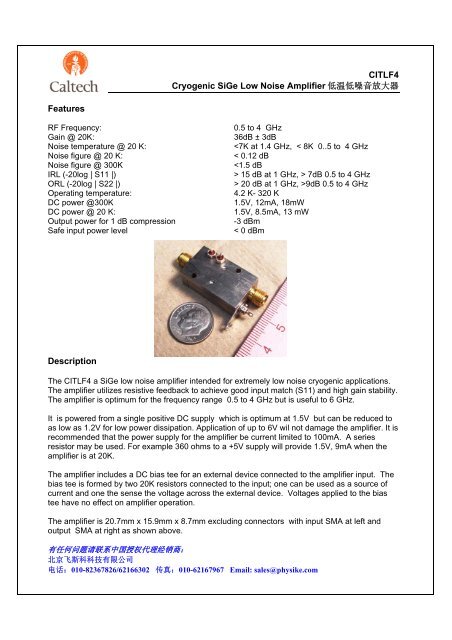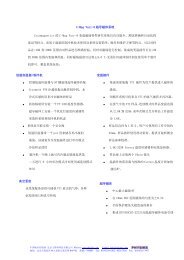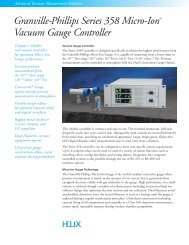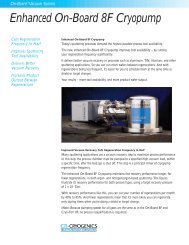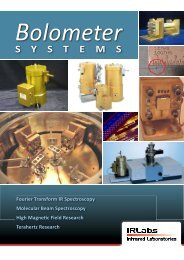CITLF4 Cryogenic SiGe Low Noise Amplifier 低温低噪音放大器 ...
CITLF4 Cryogenic SiGe Low Noise Amplifier 低温低噪音放大器 ...
CITLF4 Cryogenic SiGe Low Noise Amplifier 低温低噪音放大器 ...
- No tags were found...
Create successful ePaper yourself
Turn your PDF publications into a flip-book with our unique Google optimized e-Paper software.
<strong>CITLF4</strong><strong>Cryogenic</strong> <strong>SiGe</strong> <strong>Low</strong> <strong>Noise</strong> <strong>Amplifier</strong> 低 温 低 噪 音 放 大 器FeaturesRF Frequency:Gain @ 20K:<strong>Noise</strong> temperature @ 20 K:<strong>Noise</strong> figure @ 20 K:<strong>Noise</strong> figure @ 300KIRL (-20log | S11 |)ORL (-20log | S22 |)Operating temperature:DC power @300KDC power @ 20 K:Output power for 1 dB compressionSafe input power level0.5 to 4 GHz36dB ± 3dB 7dB 0.5 to 4 GHz> 20 dB at 1 GHz, >9dB 0.5 to 4 GHz4.2 K- 320 K1.5V, 12mA, 18mW1.5V, 8.5mA, 13 mW-3 dBm< 0 dBmDescriptionThe <strong>CITLF4</strong> a <strong>SiGe</strong> low noise amplifier intended for extremely low noise cryogenic applications.The amplifier utilizes resistive feedback to achieve good input match (S11) and high gain stability.The amplifier is optimum for the frequency range 0.5 to 4 GHz but is useful to 6 GHz.It is powered from a single positive DC supply which is optimum at 1.5V but can be reduced toas low as 1.2V for low power dissipation. Application of up to 6V wil not damage the amplifier. It isrecommended that the power supply for the amplifier be current limited to 100mA. A seriesresistor may be used. For example 360 ohms to a +5V supply will provide 1.5V, 9mA when theamplifier is at 20K.The amplifier includes a DC bias tee for an external device connected to the amplifier input. Thebias tee is formed by two 20K resistors connected to the input; one can be used as a source ofcurrent and one the sense the voltage across the external device. Voltages applied to the biastee have no effect on amplifier operation.The amplifier is 20.7mm x 15.9mm x 8.7mm excluding connectors with input SMA at left andoutput SMA at right as shown above.有 任 何 问 题 请 联 系 中 国 授 权 代 理 经 销 商 :北 京 飞 斯 科 科 技 有 限 公 司电 话 :010-82367826/62166302 传 真 :010-62167967 Email: sales@physike.com
<strong>CITLF4</strong><strong>Cryogenic</strong> <strong>SiGe</strong> <strong>Low</strong> <strong>Noise</strong> <strong>Amplifier</strong> 低 温 低 噪 音 放 大 器Typical Test DataTypical S Parameters at 25KVdIdS11 and S21 vs Bias at 25KS11S21PmW 1 GHz 3 GHz 5.5 GHz 1 GHz 3 GHz 5.5 GHz1.1 1.7 1.9 ‐7.5 ‐2.9 ‐5.4 22.4 18.9 18.81.2 3.2 3.81.3 5 6.5 ‐23 ‐7.6 ‐8.8 33.5 31.3 25.91.5 8.3 12.5 ‐14.6 ‐11.5 ‐10.5 38 35.2 281.7 11.8 20.1有 任 何 问 题 请 联 系 中 国 授 权 代 理 经 销 商 :北 京 飞 斯 科 科 技 有 限 公 司电 话 :010-82367826/62166302 传 真 :010-62167967 Email: sales@physike.com
Note the sensitivity of gain to DC bias voltage. At 1.5V bias the slope is 1.4 dB per0.1 volt bias change. This is a ΔG/ΔV of 5.7% per 1%. A .01% power supply givesa gain stability of .06% or .0026 dB.Use care to not bend (and break) the DC bias pin when tightening the output SMAconnector.Bias Tee SchematicTo order amplifier with 5K biasresistors add -5K to modelnumberInput SMA20K0.1uFRFfiltercap20KSource Sense100 pF0.1uFRFfiltercapTo LNAinputtransistor有 任 何 问 题 请 联 系 中 国 授 权 代 理 经 销 商 :北 京 飞 斯 科 科 技 有 限 公 司电 话 :010-82367826/62166302 传 真 :010-62167967 Email: sales@physike.com


